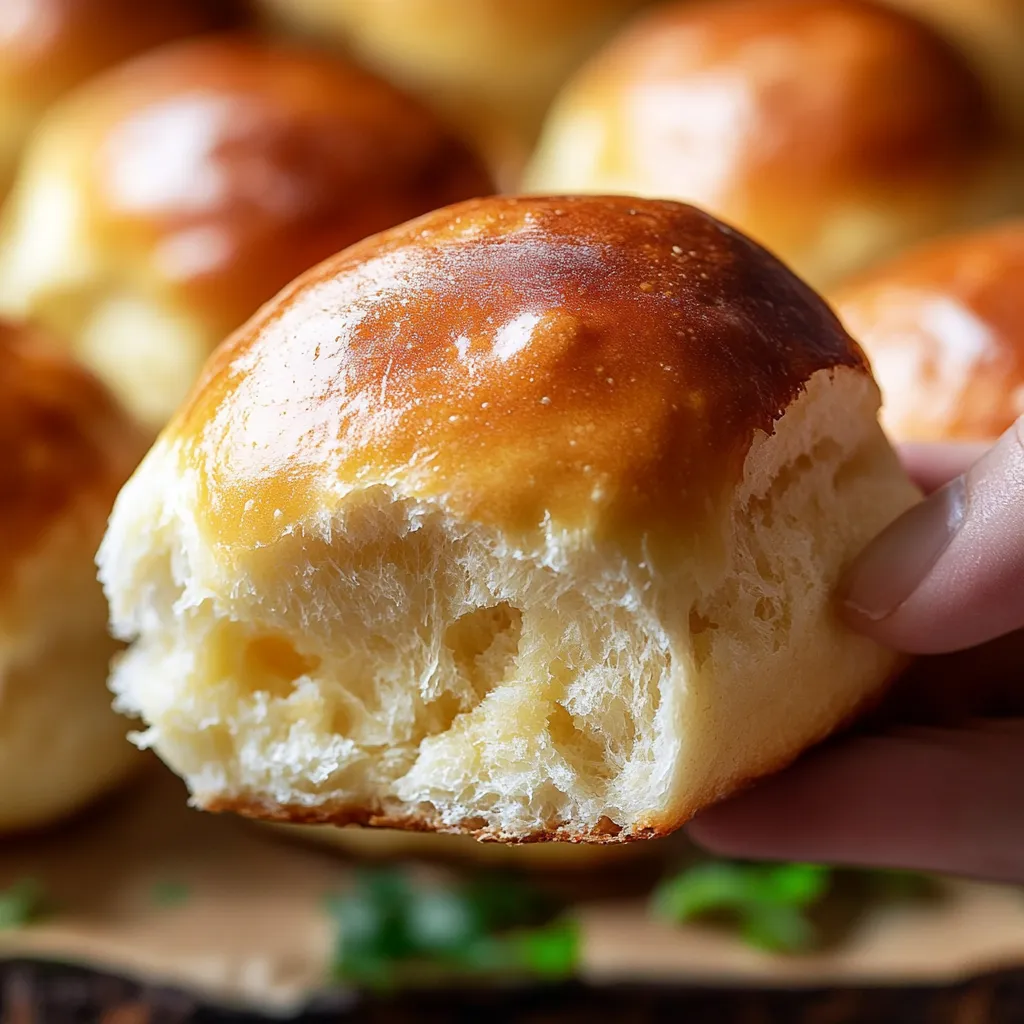 Pin
Pin
This sweet and fluffy homemade Hawaiian rolls recipe has completely replaced store-bought versions in my kitchen. The perfect balance of pineapple sweetness and pillowy texture makes these irresistible for everything from holiday dinners to everyday sandwiches.
I first developed this recipe when trying to recreate my grandmother's famous holiday rolls. After several attempts, my family unanimously declared these even better than the store-bought version we had relied on for years.
Ingredients
- Canned pineapple juice: Provides that signature Hawaiian roll flavor and helps tenderize the dough
- Whole milk: Adds richness that enhances the tender crumb structure
- Melted butter: Creates that melt-in-your-mouth quality everyone loves
- Granulated and light brown sugars: Offer balanced sweetness without being overwhelming
- Room temperature eggs: Provide structure and richness
- Vanilla extract: Enhances the sweet notes without making them taste like dessert
- Instant yeast: Speeds up the process compared to active dry yeast
- Bread flour: Gives these rolls their perfect chewy texture and structure
- All-purpose flour: Helps balance the protein content for the ideal texture
- Fine salt: Balances the sweetness and enhances all flavors
Step-by-Step Instructions
- Combine Wet Ingredients:
- Add pineapple juice, warm milk, melted butter, both sugars, eggs, vanilla and yeast to your stand mixer bowl. Stir gently to combine. The liquid should feel just warm to the touch, not hot enough to kill the yeast.
- Add Partial Flour:
- Add the all-purpose flour and 2 cups of bread flour to create a shaggy dough mass. This gradual flour addition prevents adding too much, which would make tough rolls. Stir in the salt at this point to ensure even distribution.
- Knead To Perfection:
- With the dough hook attachment, add remaining bread flour gradually until the dough comes together. Only add flour until the dough pulls away from the sides but still feels slightly tacky. Knead for 4-5 minutes until smooth and elastic. The dough should pass the windowpane test if you stretch a small piece.
- First Rise:
- Place the dough in a lightly greased bowl and cover with plastic wrap. Let rise in a warm spot until doubled, about 90 minutes. The dough should look puffy and yield to gentle pressure from your finger.
- Shape The Rolls:
- Gently deflate the dough and divide into 15 equal pieces. For perfectly uniform rolls, weigh the entire dough mass and divide by 15. Shape each piece by pulling the edges toward the center and pinching closed, then roll under your palm to create tension on the surface.
- Second Rise:
- Arrange rolls in your prepared baking pan, brush with egg wash, and cover. Let rise until visibly puffy and doubled, about 1 hour. They should be touching or nearly touching each other in the pan.
- Bake To Golden Perfection:
- Bake at 375°F for exactly 20 minutes until the tops are a rich golden brown. Immediately brush with melted butter for that signature glossy, soft top. The internal temperature should reach 190°F when fully baked.
The secret ingredient that makes these rolls truly special is the pineapple juice. I discovered its magic after experimenting with various fruit juices, and nothing else produces that distinctive Hawaiian roll flavor. My nephew, who normally refuses anything homemade, actually requested these for his birthday dinner last year, which I consider the ultimate stamp of approval.
Storage Solutions
These Hawaiian rolls stay fresh at room temperature in an airtight container for up to 3 days. For longer storage, freeze them in a ziplock bag with as much air removed as possible. They thaw quickly at room temperature and can be refreshed with a quick 10-second microwave blast or 5 minutes in a warm oven. This makes them perfect for meal prep as you can make a double batch and freeze half for later.
Perfect Pairings
Hawaiian rolls shine brightest when served alongside foods with contrasting flavors. Their subtle sweetness complements savory dishes like pulled pork, ham, or barbecue chicken. They make outstanding slider buns for party appetizers. For breakfast, try them with a smear of cream cheese and fresh fruit preserves. My family tradition is serving them warm with cinnamon honey butter during holiday meals.
Troubleshooting Tips
If your dough seems too sticky during kneading, resist adding much extra flour. A slightly tacky dough produces softer rolls. Instead, lightly oil your hands when handling. If rolls brown too quickly in the oven, loosely tent with foil after the first 10 minutes. For rolls that rise slowly, create a warm environment by preheating your oven to its lowest setting, turning it off, and placing the covered dough inside with the door cracked open.
Recipe Questions & Answers
- → Can I use active dry yeast instead of instant yeast?
Yes, you can substitute active dry yeast for instant yeast. Simply mix it with the warm milk (100-110°F) and let it proof for 5 minutes before adding it to the dough. The rise time may increase by about 20%.
- → What can I use instead of canned pineapple juice?
If canned pineapple juice isn’t available, fresh pineapple juice works as a great substitute. Be sure it's at room temperature before using.
- → Can I make the dough ahead of time?
Yes, you can prepare the dough a day ahead. After the first rise, cover it tightly and refrigerate overnight. Allow it to come to room temperature before shaping and baking.
- → Why are my rolls not fluffy?
Ensure you use the correct amount of flour—adding too much can make the rolls dense. Don’t skip the rising time, and check your yeast’s freshness for effective leavening.
- → How should I store leftover rolls?
Store leftover rolls in an airtight container at room temperature for up to 3 days. For longer storage, freeze them and reheat before serving.